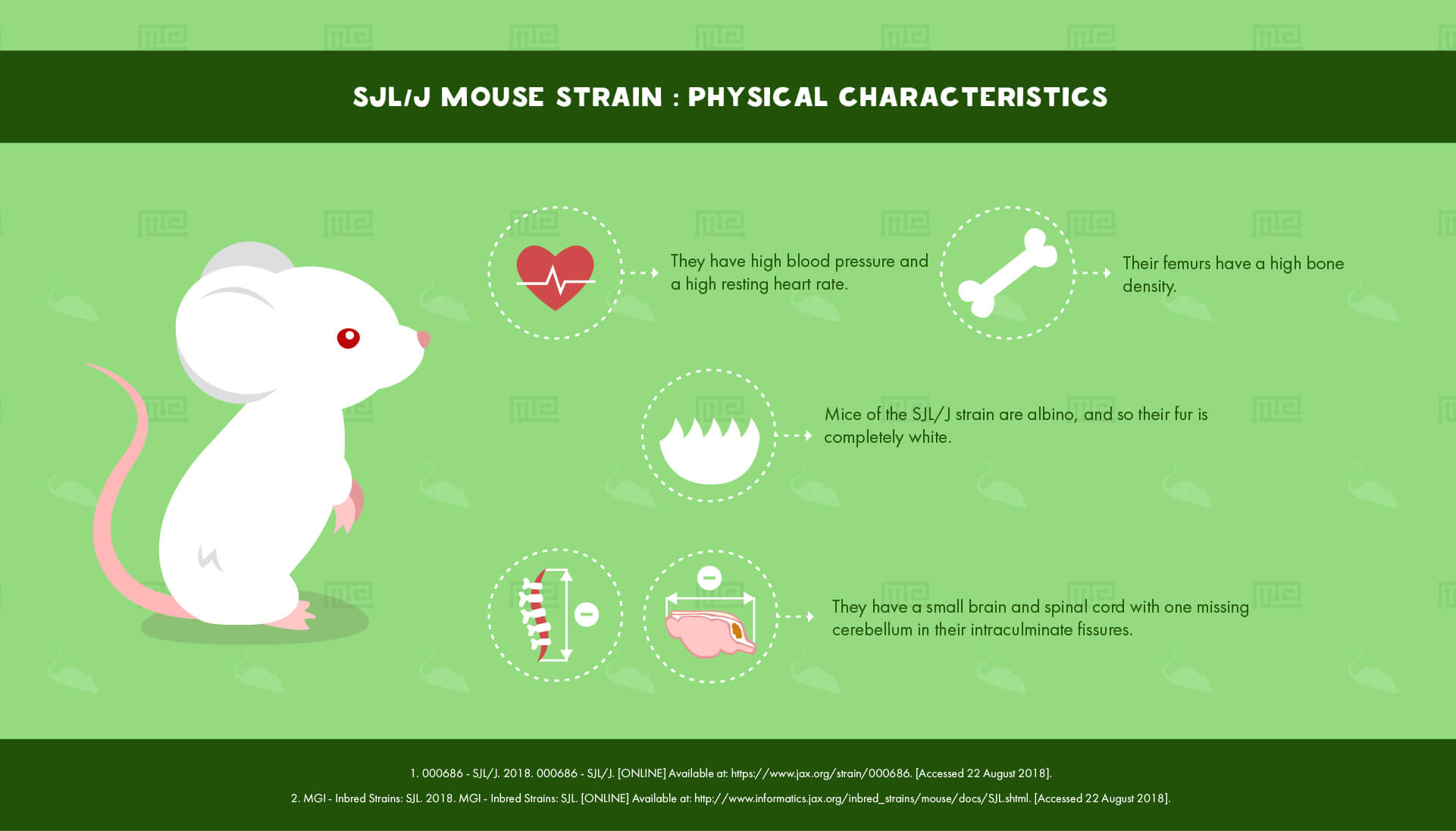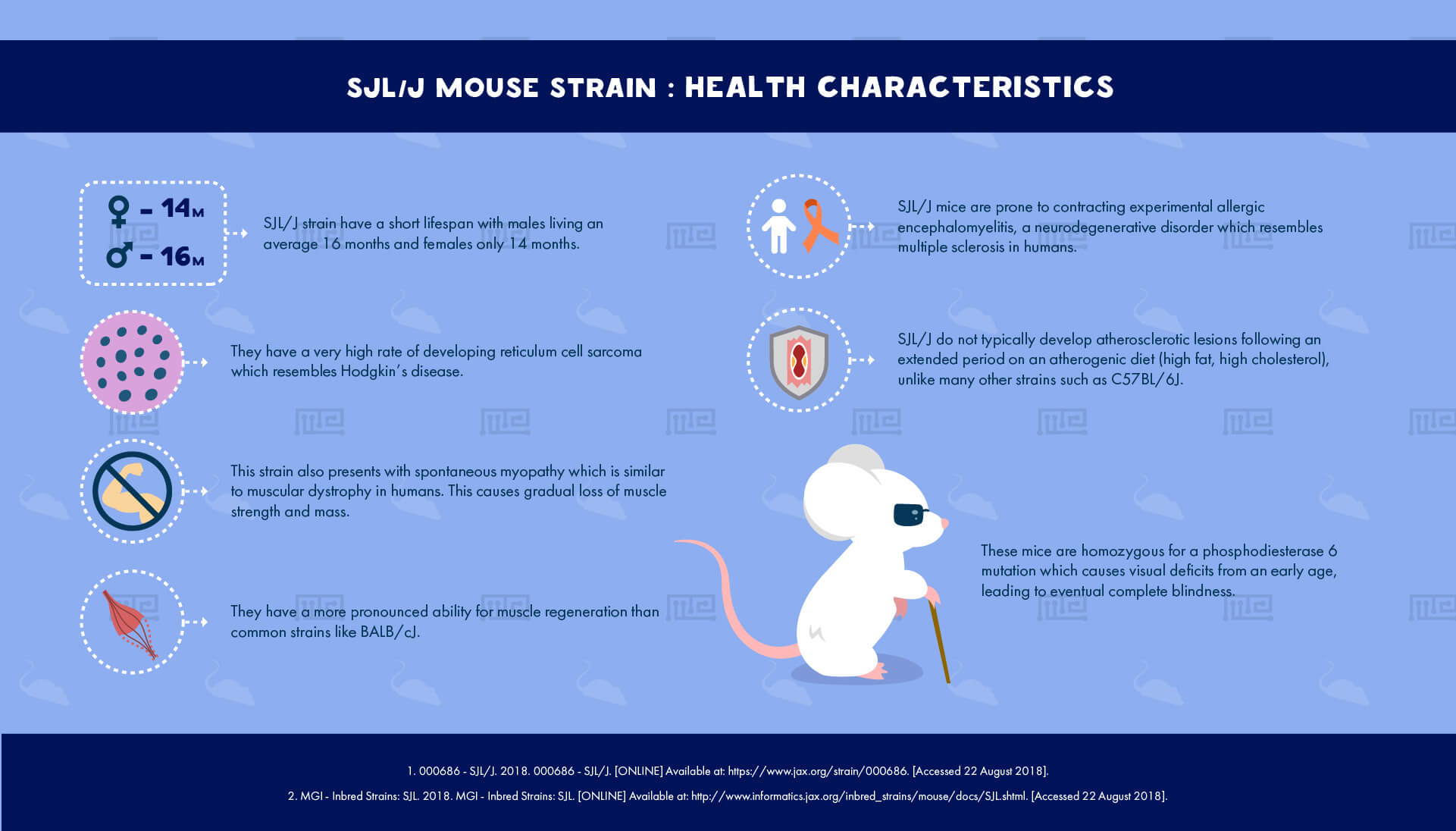Overview
SJL/J is a popular inbred strain of mouse model that is most frequently noted for its high incidence of sarcoma.
Physical Characteristics
Mice of the SJL/J strain are albino, and so their fur is completely white.[1] Their brain and spinal cord are small, and their cerebellum is missing one of its intraculminate fissures. Their femurs have a high bone density. They have high blood pressure and a high resting heart rate.[2]
Behavioral Characteristics & Handling
Male SJL/J mice are well known to exhibit much higher than normal levels of aggression.[1] In fact, their intra-strain aggression is so severe that researchers in one study[3] assert it would be inhumane not to house individuals separately.
These aggressive tendencies, however, do not seem to extend into the realm of handling by humans. A Canadian study[4] looking at the relative ease of handling of a number of commonly used mouse strains reports that SJL/J mice were quite placid, around as placid as the BTBR and C58/J strains, showing minimal struggling when held or evasiveness during capture. Their squeaking was moderately frequent.
SJL/J mice have shown low anxiety in the elevated plus maze test and light dark box test.[5] This strain is also described as “sweet sensitive” and has a strong preference for sucrose.[6] SJL/J mice should most likely not be used in locomotor testing paradigms such as forced swimming or rotarod, as their myopathic phenotype gives them severe motor difficulties.
Health Characteristics
Lifespan is short for these mice, on account of several major medical abnormalities. Males live on average 16 months, with females only averaging 14 months.[2]
The SJL/J mice is most well known for its very high rate of developing reticulum cell sarcoma which resembles Hodgkin’s disease. The tumors are present in 90% of individuals from around one year of age. They appear first in the lymphatic system and spleen, before spreading to the liver and thymus. Most of these tumors are what is known as “type B” mixed cell tumors.[1][2]
This strain also presents with a spontaneous myopathy that is conferred by the mutant allele Dysfim of the dysferlin gene, resulting in lower expression of this protein. The myopathy is similar to muscular dystrophy in humans. The mice gradually lose muscle strength and mass, which coincides with abnormalities in muscle cell morphology, and fat intrusion into muscle tissue. However, this strain also has a more pronounced ability for muscle regeneration than more common strains like BALB/cJ.[1]
SJL/J mice are prone to contracting experimental allergic encephalomyelitis (EAE), a neurodegenerative disorder which resembles multiple sclerosis in humans. Unlike many other strains such as C57BL/6J, SJL/J do not typically develop atherosclerotic lesions following an extended period on an atherogenic diet (high fat, high cholesterol). Also, these mice are homozygous for a phosphodiesterase 6 mutation which causes visual deficits from an early age, leading to eventual complete blindness.[1]
Major Experimental Uses
The main research application for the SJL/J mice is in the study of cancer, especially Hodgkin’s disease. They are also used in research on atherosclerosis, diabetes, autoimmunity, demyelinating diseases, muscular dystrophy, virology, and retinal degeneration.[1]
References
- 000686 – SJL/J. 2018. 000686 – SJL/J. [ONLINE] Available at: https://www.jax.org/strain/000686. [Accessed 22 August 2018].
- MGI – Inbred Strains: SJL. 2018. MGI – Inbred Strains: SJL. [ONLINE] Available at: http://www.informatics.jax.org/inbred_strains/mouse/docs/SJL.shtml. [Accessed 22 August 2018].
- Abigail L. Smith & Dorcas J. Corrow. Modifications to Husbandry and Housing Conditions of Laboratory Rodents for Improved Well-being. ILAR Journal, Volume 46, Issue 2, 1 January 2005, Pages 140–147.
- Wahlsten, D. Metten, P. Crabbe, JC. 2003. A rating scale for the wildness and ease of handling laboratory mice: results for 21 inbred strains tested in two laboratories. Genes, Brain and Behavior. 2; 71-79.
- Griebel G, Belzung C, Perrault G, Sanger DJ. Differences in anxiety-related behaviours and insensitivity to diazepam in inbred and outbred strains of mice. Psychopharmacology (Berl). 2000 Feb;148(2):164-70.
- Pinhas, A., Aviel, M., Koen, M., Gurgov, S., Acosta, V., Israel, M., … Bodnar, R. J. (2012). Strain differences in Sucrose- and Fructose-Conditioned Flavor Preferences in Mice. Physiology & Behavior, 105(2), 451–459.


